Lecture notes written by Albert Jacka VC
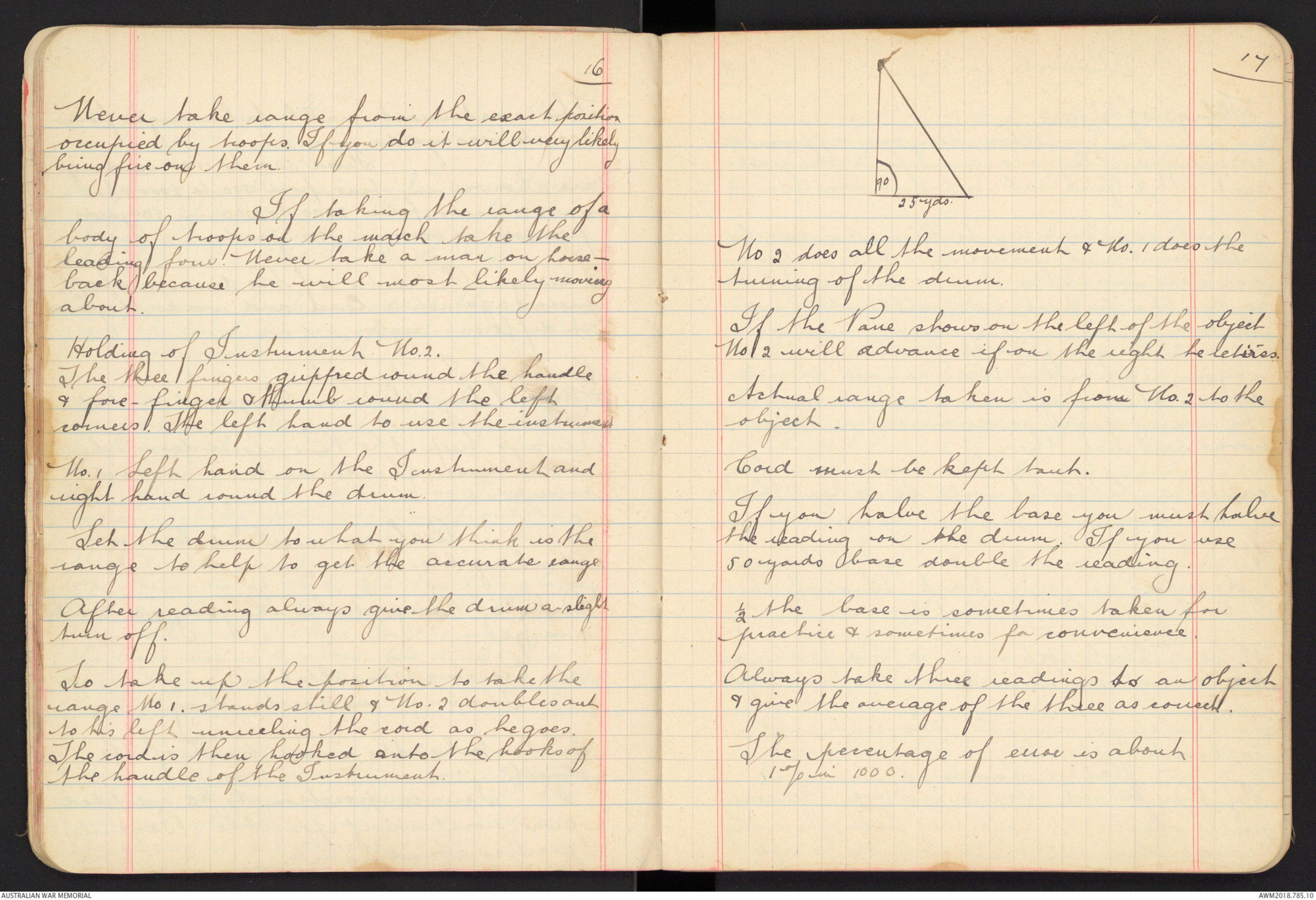
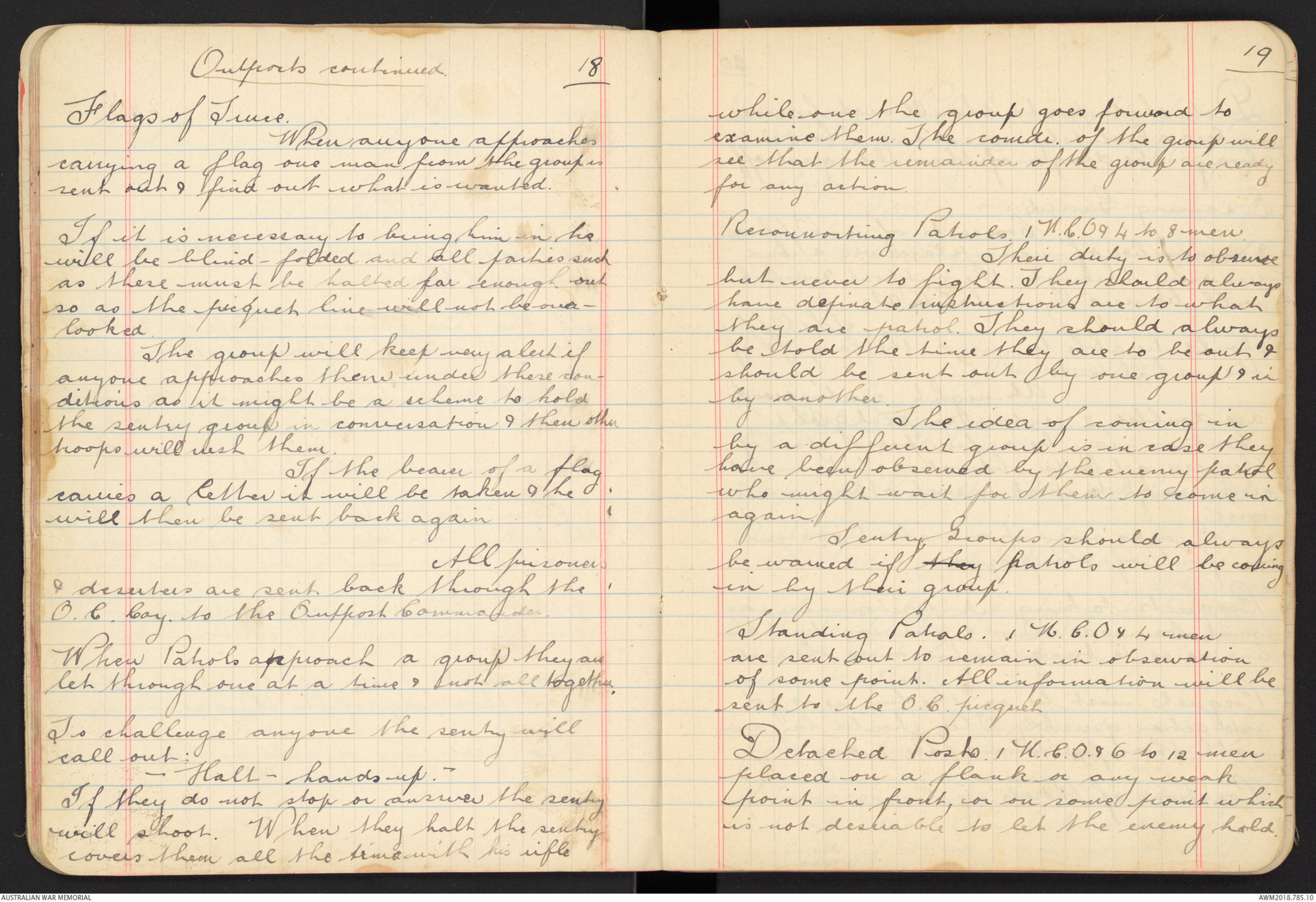
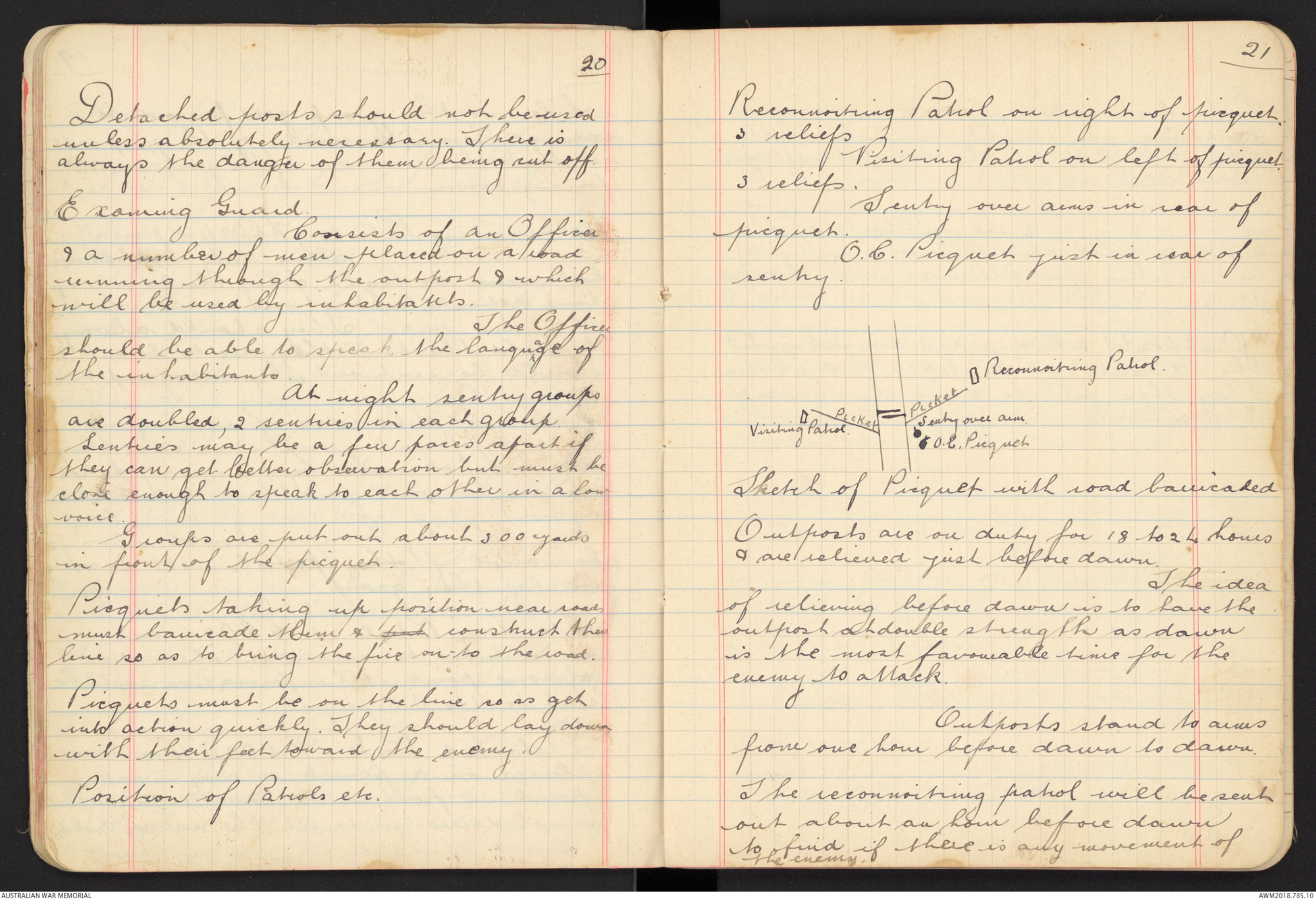
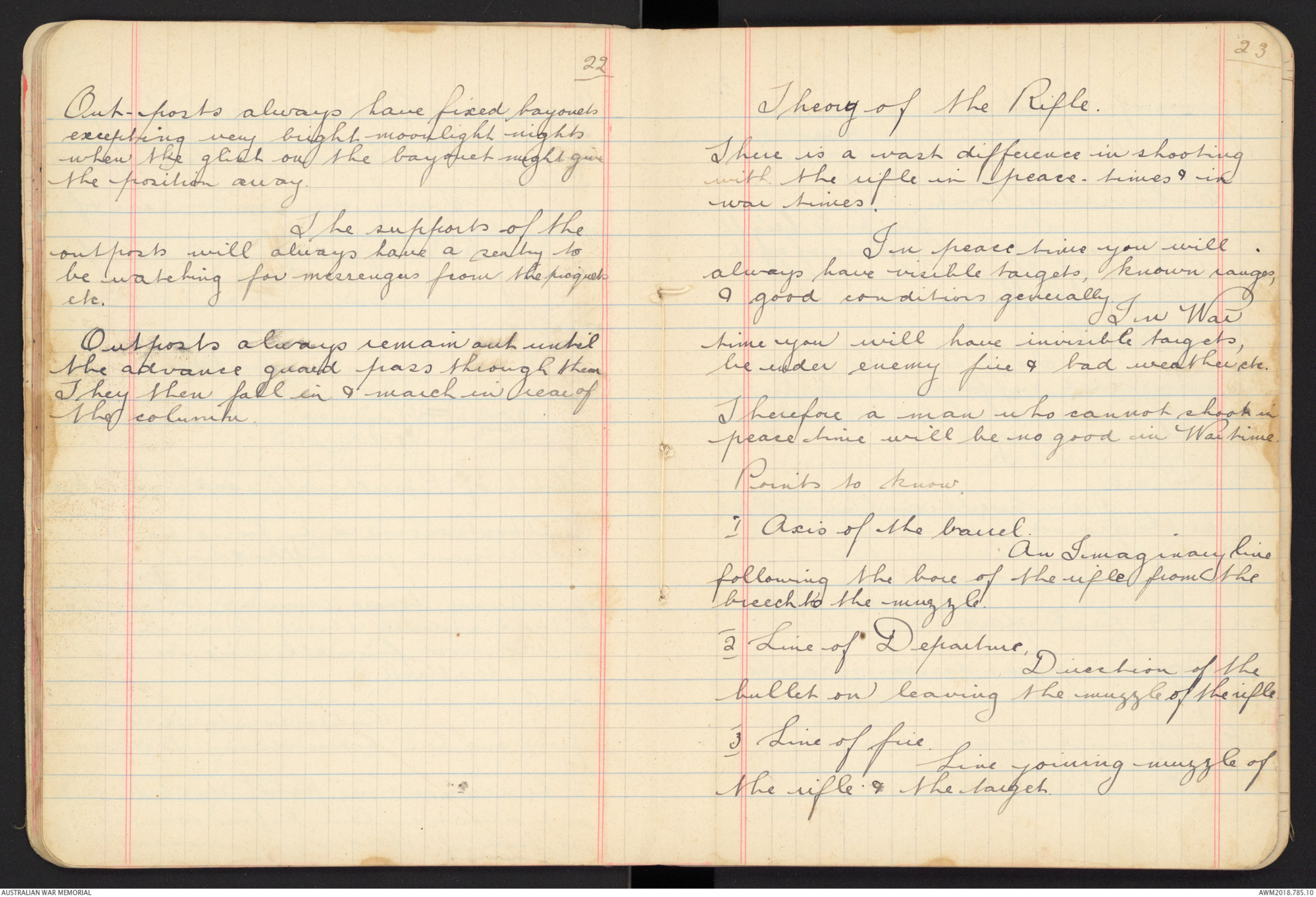
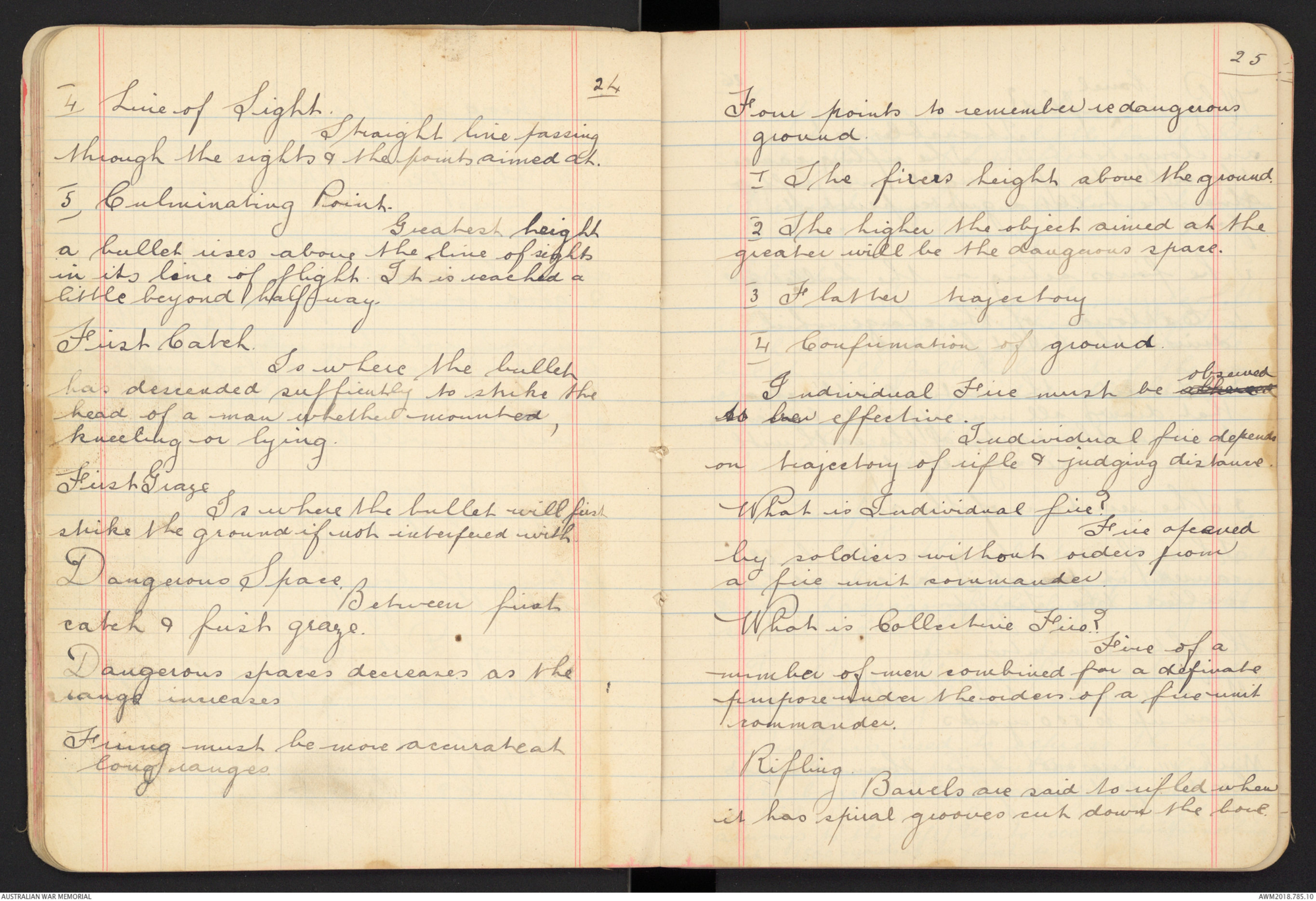
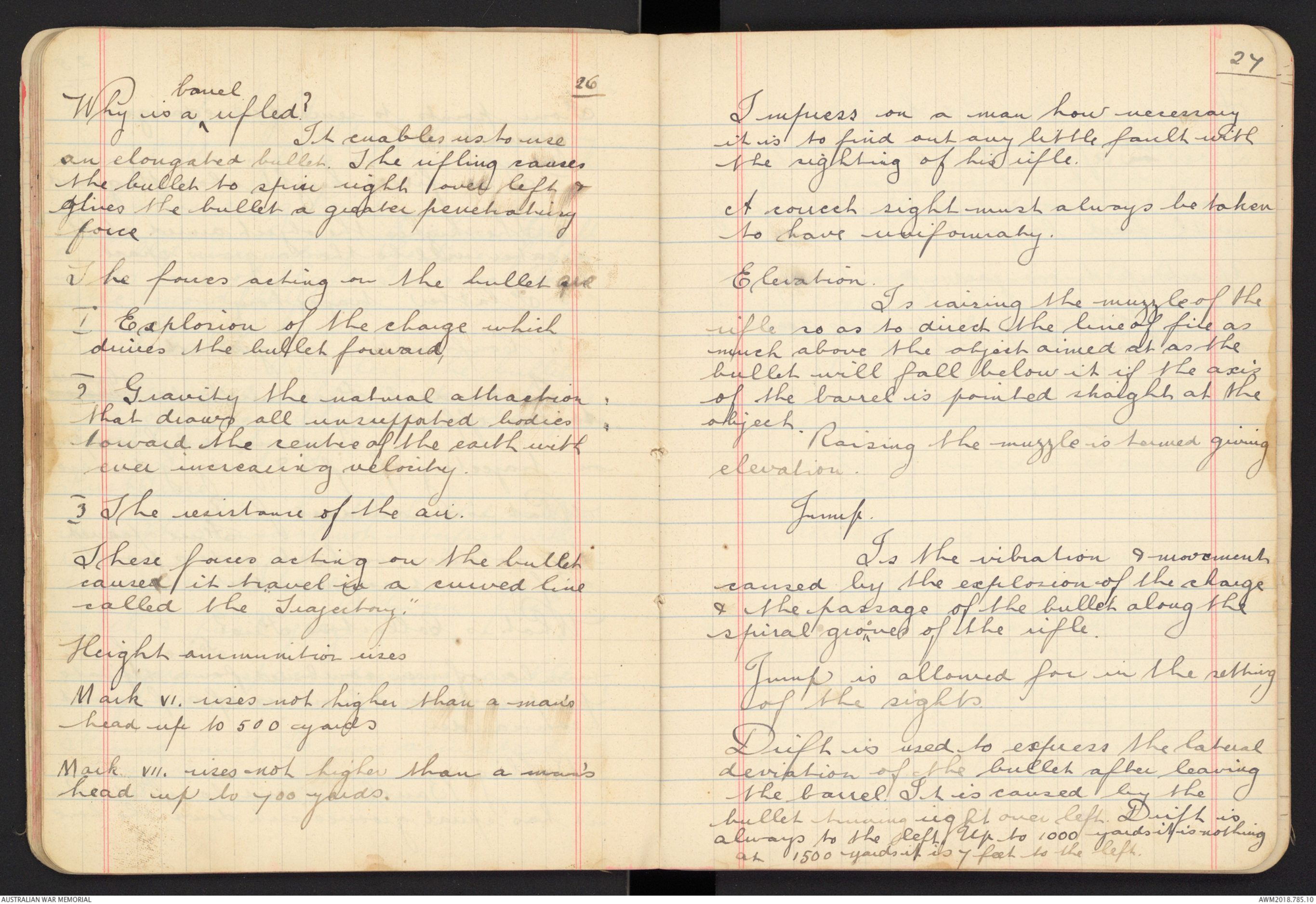
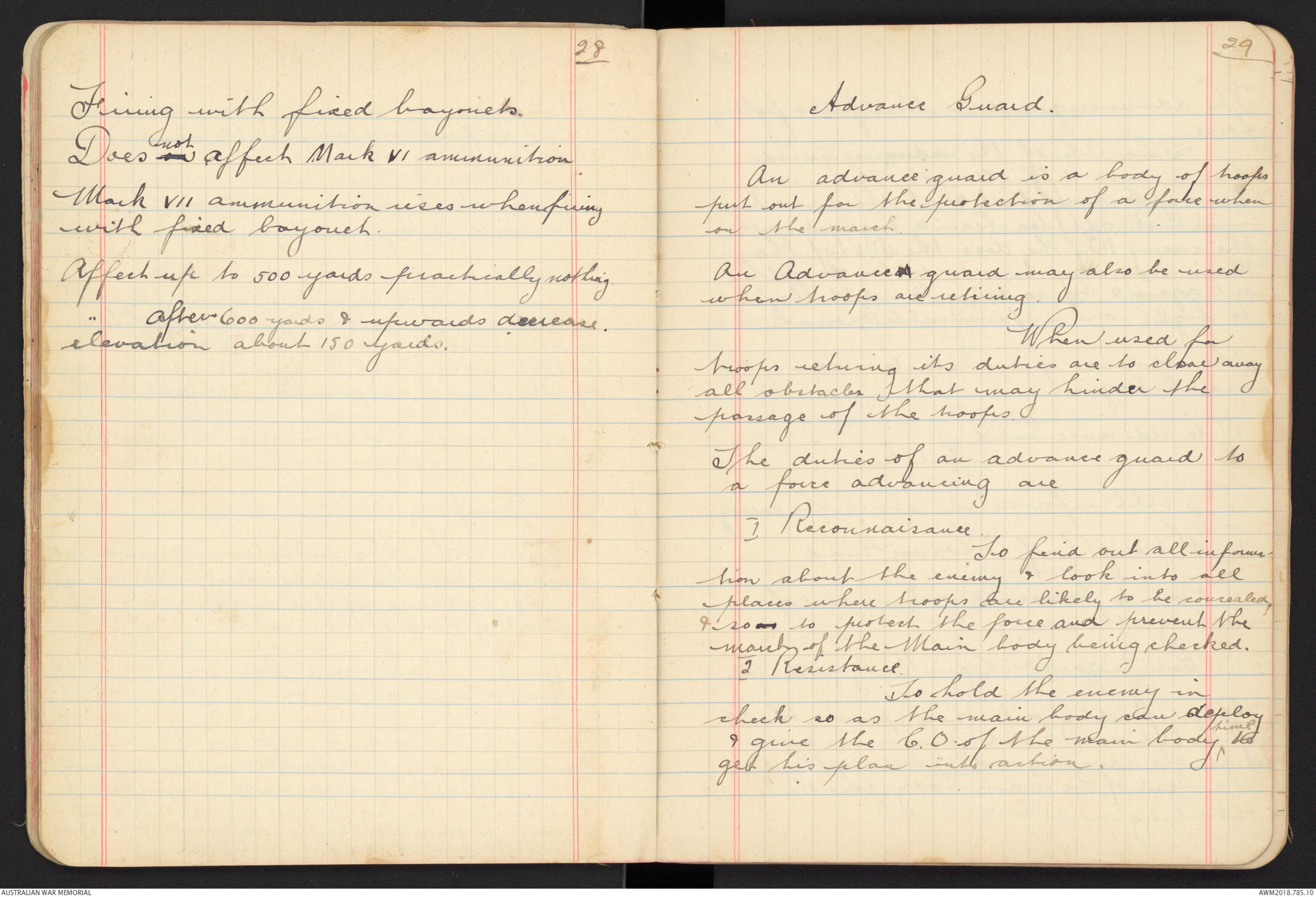
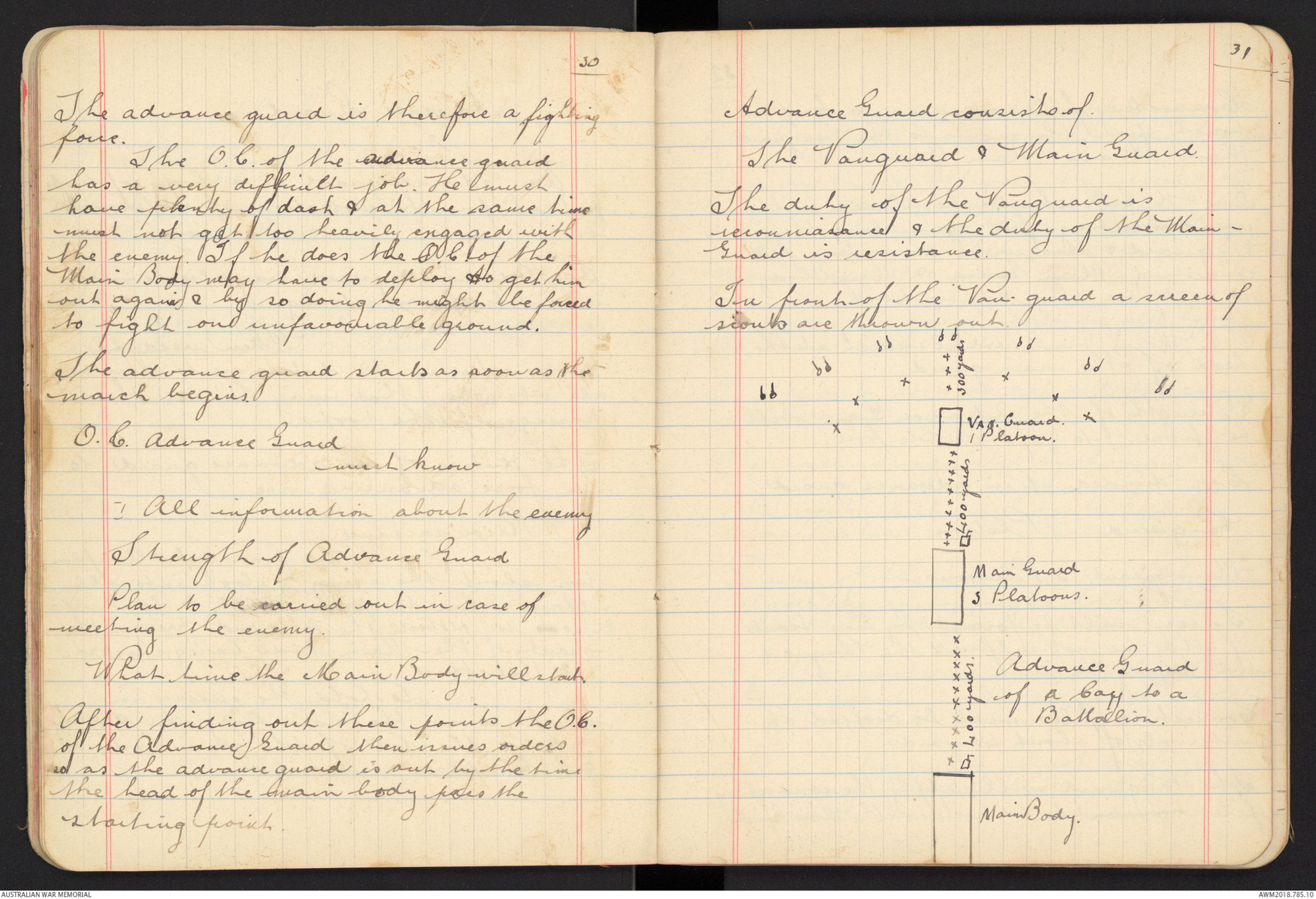
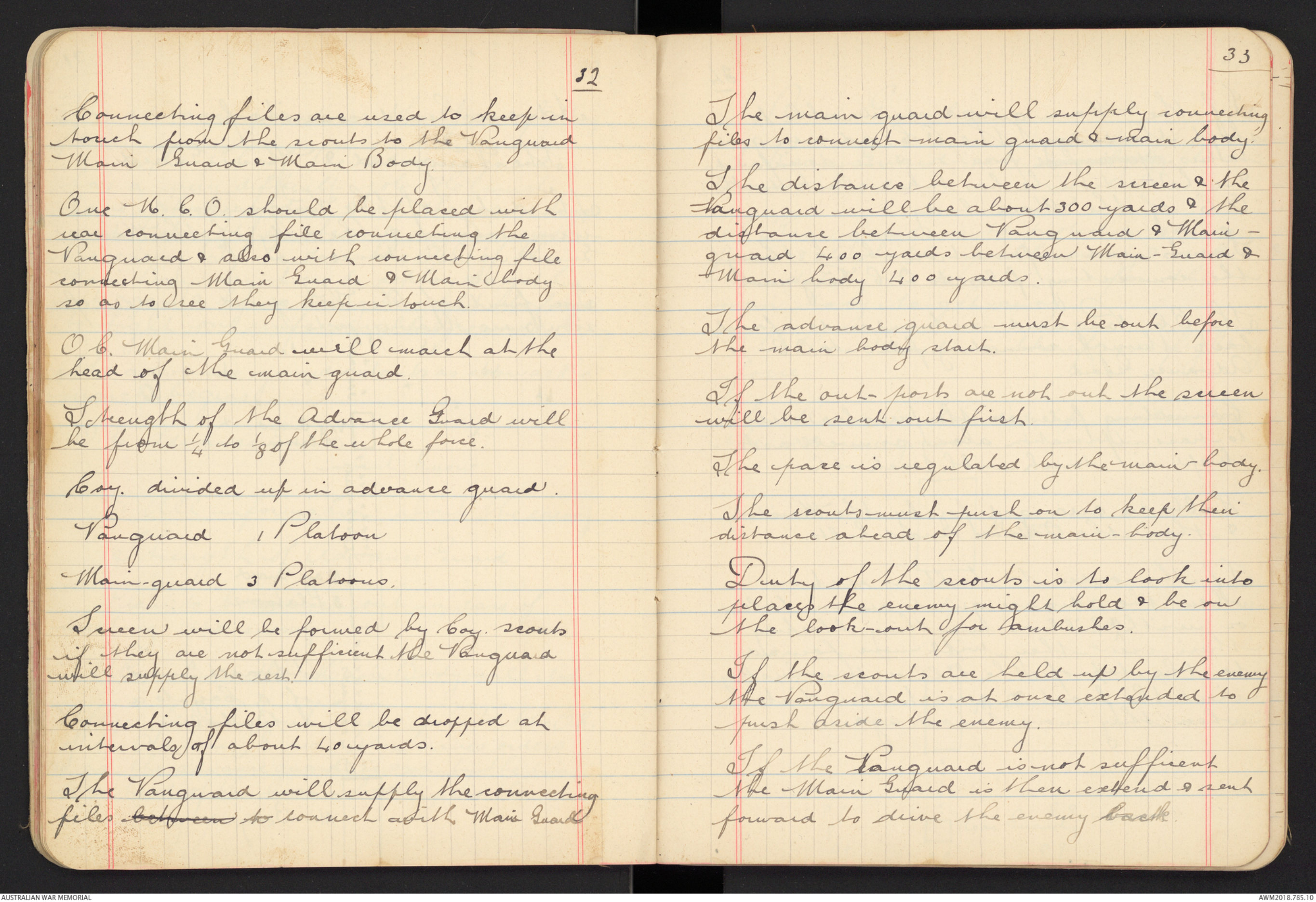
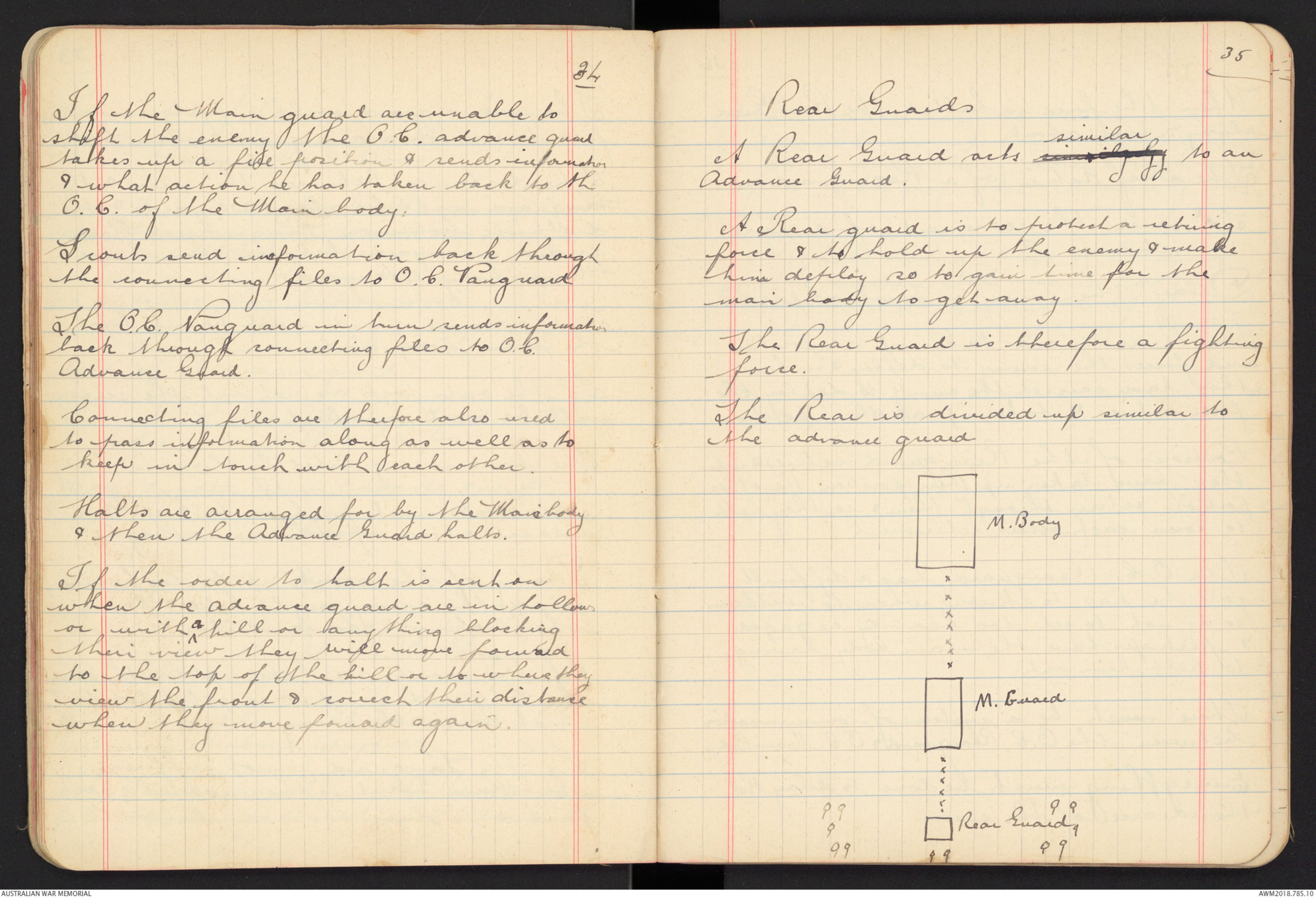
16
Never take range from the exact position
occupied by troops. If you do it will very likely
bring fire on them.
If taking the range of a
body of troops at the march take the
leading four. Never take a man on horseback
because he will most likely moving
about.
Holding of Instrument No.2.
The three fingers gripped round the handle
& fore-finger & thumb around the left
corners. The left hand to use the instrument
No. 1 Left hand on the Instrument and
right hand round the drum.
Set the drum to what you think is the
range to help to get the accurate range
After reading always give the drum a slight
turn off.
To take up the position to take the
range. No 1. stands still & No. 2 doubles out
to his left unreeling the cord as he goes.
The cord is then hooked onto the hooks of
the handle of the Instrument.
17
Diagram - see original document
No 2 does all the movement & No. 1 does the
turning of the drum.
If the Vane shows on the left of the object
No 2 will advance if on the right he retires.
Actual range taken is from No. 2 to the
object.
Cord must be kept taut.
If you halve the base you must halve
the reading on the drum. If you use
50 yards base double the reading.
½ the base is sometimes taken for
practice & sometimes for convenience.
Always take three readings to an object
& give the average of the three as correct.
The percentage of error is about
1 % in 1000.
18
Outposts continued
Flags of Truce.
When anyone approaches
carrying a flag one man from the group is
sent out & find out what is wanted.
If it is necessary to bring him in he
will be blind-folded and all parties such
as these must be halted far enough out
so as the picquet line will not be overlooked
The group will keep very alert if
anyone approaches them under these conditions
as it might be a scheme to hold
the sentry group in conversation & then other
troops will rush them.
If the bearer of a flag
carries a letter it will be taken & he
will then be sent back again
All prisoners
& deserters are sent back through the
O.C Coy. to the Outpost Commander.
When Patrols approach a group they are
let through one at a time & not all together.
To challenge anyone the sentry will
call out:
- Halt- hands up. -
If they do not stop or answer the sentry
will shoot. When they halt the sentry
covers them all the time with his rifle
19
while one the group goes forward to
examine them. The cmdr. of the group will
see that the remainder of the group are ready
for any action.
Reconnoitring Patrols 1 N.C.O. &4 to 8 men.
Their duty is to observe
but never to fight. They should always
have definate instructions are to what
they are patrol. They should always
be told the time they are to be out &
should be sent out by one group & in
by another.
The idea of coming in
by a different group is in case they
have been observed by the enemy patrol
who might wait for them to come in
again.
Sentry Groups should always
be warned if they patrols will be coming
in by their group.
Standing Patrols. 1 N.C.O & 4 men
are sent out to remain in observation
of some point. All information will be
sent to the O.C. picquet
Detached Posts 1 N.C.O & 6 to 12 men
placed on a flank or any weak
point in front, or on some point which
is not desirable to let the enemy hold.
20
Detached posts should not be used
unless absolutely necessary. There is
always the danger of them being cut off.
Examing Guard.
Consists of an Officer
& a number of men placed on a road
running through the outpost & which
will be used by inhabitants.
The Officer
should be able to speak the language of
the inhabitants.
At night sentry groups
are doubled, 2 sentries in each group.
Sentries may be a few paces apart if
they can get better observation but must be
close enough to speak to each other in a low
voice.
Groups are put out about 500 yards
in front of the picquet.
Picquets taking up position near road
must barricade them & put construct their
line so as to bring the fire on-to the road.
Picquets must be on the line so as get
into action quickly. They should lay down
with their feet toward the enemy.
Position of Patrols etc.
21
Reconnoitring Patrol on right of picquet.
2 reliefs
Visiting Patrol on left of picquet.
3 reliefs
Sentry over arms in rear of
picquet
O.C. Picquet just in rear of
sentry.
Diagram - see original document
Outposts are on duty for 18 to 24 hours
& are relieved just before dawn.
The idea
of relieving before dawn is to have the
outpost at double strength as dawn
is the most favourable time for the
enemy to attack.
Outposts stand to arms
from one hour before dawn to dawn.
The reconnoitring patrol will be sent
out about an hour before dawn
to find if there is any movement of
the enemy.
22
Outposts always have fixed bayonets
excepting very bright moonlight nights
when the glint on the bayonet might give
the position away.
The supports of the
outposts will always have a sentry to
be watching for messengers from the picquet
etc.
Outposts always remain out until
the advance guard pass through them
They then fall in & march in rear of
the column.
23
Theory of the Rifle.
There is a vast difference in shooting
with the rifle in peace-times & in
war times.
In peace time you will
always have visible targets, known ranges,
& good conditions generally.
In War
time you will have invisible targets,
be under enemy fire & bad weather etc.
Therefore a man who cannot shoot in
peace time will be no good in War time
Points to know.
(1) Axis of the barrel.
An Imaginary line
following the bore of the rifle from the
breech to the muzzle.
(2) Line of Departure.
Direction of the
bullet on leaving the muzzle of the rifle
(3) Line of fire
Line joining muzzle of
the rifle & the target.
24
(4) Line of Sight.
Straight line passing
through the sights & the points aimed at.
(5) Culminating Point.
Greatest height
a bullet uses above the line of sights
in its line of flight. It is reached a
little beyond half-way.
First Catch.
To where the bullet
has descended sufficiently to strike the
head of a man whether mounted,
kneeling or lying.
First Graze
Is where the bullet will first
strike the ground if not interfered with.
Dangerous Space.
Between first
catch & first graze.
Dangerous spaces decreases as the
range increases
Firing must be more accurate at
long ranges.
25
Four points to remember re dangerous
ground.
(1)The firers height above the ground.
(2) The higher the object aimed at the
greater will be the dangerous space.
(3) Flatter trajectory
(4) Confirmation of ground.
Individual Fire must be shown observed
to be effective.
Individual fire depends
on trajectory of rifle & judging distance.
What is Individual fire?
Fire opened
by soldiers without orders from
a fire unit commander.
What is Collective Fire?
Fire of a
number of men combined for a definate
purpose under the orders of a fire unit
commander.
Rifling.
Barrels are said to rifled when
it has spiral grooves cut down the bore.
26
Why is a ^barrel rifled?
It enables us to use
an elongated bullet. The rifling causes
the bullet to spin right over left &
gives the bullet a greater penetrating
force.
The forces acting on the bullet are
(1) Explosion of the charge which
drives the bullet forward.
(2) Gravity the natural attraction
that draws all unsupported bodies
toward the centre of the earth with
ever increasing velocity.
(3) The resistance of the air.
These forces acting on the bullet
caused it travel in a curved line
called the "Trajectory."
Height ammunition uses
Mark VI. rises not higher than a man's
head up to 500 yards
Mark VII. rises not higher than a man's
head up to 700 yards.
27
Impress on a man how necessary
it is to find out any little fault with
the sighting of his rifle.
A correct sight must always be taken
to have uniformaty.
Elevation.
Is raising the muzzle of the
rifle so as to direct the line of fire as
much above the object aimed at as the
bullet will fall below it if the axis
of the barrel is pointed straight at the
object.
Raising the muzzle is formed giving
elevation.
Jump.
Is the vibration & movements
caused by the explosion of the charge
& the passage of the bullet along the
spiral grooves of the rifle.
Jump is allowed for in the setting
of the sights.
Drift is used to express the lateral
deviation of the bullet after leaving
the barrel. It is caused by the
bullet turning right over left. Drift is
always to the left up to 1000 yards it is nothing
At 1500 yards it is 7 feet to the left.
28
Firing with fixed bayonets.
Does xxx not affect Mark VI ammunition.
Mark VII ammunition rises when firing
with fixed bayonet.
Affect up to 500 yards practically nothing.
" After 600 yards & upwards decrease.
elevation about 150 yards.
29
Advance Guard.
An advance guard is a body of troops
put out for the protection of a force when
on the march.
An Advanced guard may also be used
when troops are retiring.
When used for
troops retiring its duties are to clear away
all obstacles that may hinder the
passage of the troops.
The duties of an advance guard to
a force advancing are
(1) Reconnaisance.
To find out all information
about the enemy & look into all
places where troops are likely to be concealed
& so as to protect the force and prevent the
march of the Main body being checked.
(2) Resistance.
To hold the enemy in
check so as the main body can deploy
& give the C.O. of the main body ^time to
get his plan into action.
30
The advance guard is therefore a fighting
force.
The O.C. of the advance guard
has a very difficult job. He must
have plenty of dash & at the same time
must not get too heavily engaged with
the enemy. If he does the O.C of the
Main Body may have to deploy to get him
out again & by so doing he might be forced
to fight on unfavourable ground.
The advance guard starts as soon as the
march begins.
O.C. Advance Guard
must know
(1) All information about the enemy
Strength of Advance Guard
Plan to be carried out in case of
meeting the enemy.
What time the Main Body will start.
After finding out these points the O.C.
of the Advance Guard then issues orders
so as the advance guard is out by the time
the head of the main body pass the
starting point.
31
Advance Guard consists of.
The Vanguard & Main Guard.
The duty of the Vanguard is
reconniasance & the duty of the Main-Guard
is resistance.
In front of the Van-guard a screen of
scouts are thrown out
Diagram - see original document
32
Connecting files are used to keep in
touch from the scouts to the Vanguard
Main Guard & Main Body.
One N.C.O. should be placed with
rear connecting file connecting the
Vanguard & also with connecting file
connecting Main Guard & Main body
so as to see they keep in touch.
O.C. Main Guard will march at the
head of the main guard.
Strength of the Advance Guard will
be from 1/4 to 1/8 of the whole force.
Coy. divided up in advance guard.
Vanguard 1 Platoon
Main-guard 3 Platoons.
Screen will be formed by Coy. scouts
if they are not sufficient the Vanguard
will supply the rest.
Connecting files will be dropped at
intervals of about 40 yards.
The Vanguard will supply the connecting
files between to connect with Main Guard.
33
The main guard will supply connecting
files to connect main guard & main body.
The distances between the screen & the
Vanguard will be about 300 yards & the
distance between Vanguard & Main-guard
400 yards between Main-Guard &
Main body 400 yards.
The advance guard must be out before
the main body start.
If the out-posts are not out the screen
will be sent out first.
The pace is regulated by the main-body.
The scouts must push on to keep their
distance ahead of the main-body.
Duty of the scouts is to look into
places the enemy might hold & be on
the look-out for ambushes.
If the scouts are held up by the enemy
the Vanguard is at once extended to
push aside the enemy.
If the Vanguard is not sufficient
the Main Guard is then extend & sent
forward to drive the enemy back.
34
If the Main guard are unable to
shift the enemy the O.C. advance guard
takes up a fire position & sends information
& what action he has taken back to the
O.C. of the Main body.
Scouts send information back through
the connecting files to O.C. Vanguard.
The O.C. Vanguard in turn sends information
back through connecting files to O.C.
Advance Guard.
Connecting files are therefore also used
to pass information along as well as to
keep in touch with each other.
Halts are arranged for by the Main body
& then the Advance Guard halts.
If the order to halt is sent on
when the advance guard are in hollows
or with ^a hill or anything blocking
their view they will move forward
to the top of the hill or to where they
view the front & correct their distance
when they move forward again.
35
Rear Guards
A Rear Guard acts similarly similar to an
Advance Guard.
A Rear guard is to protect a retiring
force & to hold up the enemy & make
him deploy so to gain time for the
main body to get away.
The Rear Guard is therefore a fighting
force.
The Rear is divided up similar to
the advance guard.
Diagram - see original document
 Sam scott
Sam scottThis transcription item is now locked to you for editing. To release the lock either Save your changes or Cancel.
This lock will be automatically released after 60 minutes of inactivity.